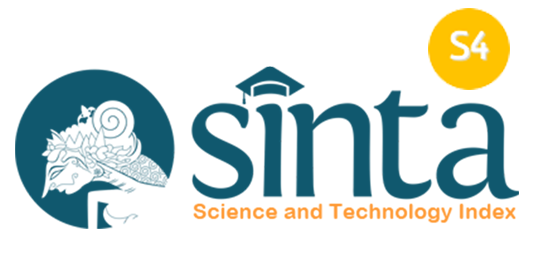Analysis of students’ mistakes in solving system of linear equation in three variables: A case on HOTS problems
Abstract
One of the serious mathematics problem faced by students happen when it relates to Higher Order Thinking Skills (HOTS) type which is compulsary of 2013 Curriculum. The purpose of this research is to describe the analysis of these types of students’ mistakes in solving mathematics problem of linear equation in three variables which used Higher Order Thinking Skills (HOTS) at SMAN Rambipuji Jember. The method used in this research is qualitative descriptive which describe the analysis' result on type of students mistakes based on Newman error indicator in terms of the students' cognitive level. The results showed that students with high cognitive level experiencing all kinds of errors with tendency to make a mistake on process error and writing the final answer. While students with moderate cognitive level is experiencing four types of errors, they are errors to understand the problem, transform problem, process error, and writing the final answer. Students with low cognitive level experience three types of errors, they are transformation problem errors, process errors, and error in writing final answer with tendency to experiencing these three types of errors in problem completion.
Keywords
Full Text:
PDFReferences
Abdullah, A. H., Abidin, N. L. Z., & Ali, M. (2015). Analysis of students’ errors in solving Higher Order Thinking Skills (HOTS) problems for the topic of fraction. Asian Social Science, 11(21), 133–142.
Afifah, D. S. N., & Ningrum, R. L. (2018). Critical thinking of field dependent student’s in problem solving. International Journal on Teaching and Learning Mathematics, 1(1), 31–38.
Agung, S., & Schwartz, M. S. (2007). Students’ understanding of conservation of matter, stoichiometry and balancing equations in Indonesia. International Journal of Science Education, 29(13), 1679-1702.
Andrews, P., & Sayers, J. (2012). Teaching linear equations: Case studies from Finland, Flanders and Hungary. The Journal of Mathematical Behavior, 31(4), 476-488.
Auzar, M. S. (2017). the relationships of reading comprehension ability with the ability to understand the questions of mathematical word problems. Mediterranean Journal of Social Sciences, 8(4-1), 145-151.
Bernardo, A. B. (1999). Overcoming obstacles to understanding and solving word problems in mathematics. Educational Psychology, 19(2), 149-163.
Brookhart, S. M. (2010). How to assess higher-order thinking skills in your classroom. ASCD.
Chidozie, C. C., Libunao, W. H., Kamen, Y. B., & Saud, M. S. B. (2014). Implementing higher order thinking skills in teaching and learning of design and technology education. In TVEIS 2014 (pp.633–640).
Goldstein, E. B. (2011). Cognitive psychology: Connecting mind, research, and everyday experience. Belmpont, CA: Wadsworth, Cengage Learning.
Kristanti, F., Ainy, C., Shoffa, S., Khabibah, S., & Amin, S. M. (2018). Developing creative-problem-solving-based student worksheets for transformation geometry course. International Journal on Teaching and Learning Mathematics, 1(1), 13–23.
Ku, Y. L., Lin, J. N., Wang, T. J., Wu, C. C., & Tseng, H. W. (2008). Critical thinking, creative thinking, problem-solving, and integrating skills merging into Clinical Case Study III. In The 19th International Nursing Research Congress Focusing on Evidence-Based Practice.
Leighton, J., & Gierl, M. (2007). Cognitive diagnostic assessment for education: Theory and applications. Cambridge University Press.
Liljedahl, P. (2018). On the Edges of Flow: Student Problem-Solving Behavior. In Broadening the Scope of Research on Mathematical Problem Solving (pp. 505-524). Springer, Cham.
Morin, L. L., Watson, S. M., Hester, P., & Raver, S. (2017). The use of a bar model drawing to teach word problem solving to students with mathematics difficulties. Learning Disability Quarterly, 40(2), 91-104.
Papaieronymou, I. (2007). Student difficulties in understanding the difference between the algebraic expressions and the concept of linear equation. In Proceedings of CERME (Vol. 5, pp. 934-943).
Prakitipong, N., & Nakamura, S. (2006). Analysis of mathematics performance of grade five students in Thailand using Newman procedure. Journal of International Cooperation in Education, 9(1), 111-122.
Raduan, I. H. (2010). Error analysis and the corresponding cognitive activities committed by year five primary students in solving mathematical word problems. Procedia - Social and Behavioral Sciences, 2(2), 3836–3838.
Rohmah, M., & Sutiarso, S. (2018). Analysis problem solving in mathematical using theory Newman. EURASIA Journal of Mathematics, Science and Technology Education, 14(2), 671-681.
White, A. L. (2010). Numeracy, literacy and Newman’s error analysis. Journal of Science and Mathematics Education in Southeast Asia, 33(2), 129-148.
Wijaya, A., van den Heuvel-Panhuizen, M., Doorman, M., & Robitzsch, A. (2014). Difficulties in solving context-based PISA mathematics tasks: An analysis of students’ errors. Mathematics Enthusiast, 11(3), 555–584.
DOI: https://doi.org/10.18860/ijtlm.v2i1.7616
Refbacks
- There are currently no refbacks.
Copyright (c) 2019 International Journal on Teaching and Learning Mathematics

This work is licensed under a Creative Commons Attribution-NonCommercial-ShareAlike 4.0 International License.
Indexed by :
.png)
.jpg)
.png)

.jpg)



